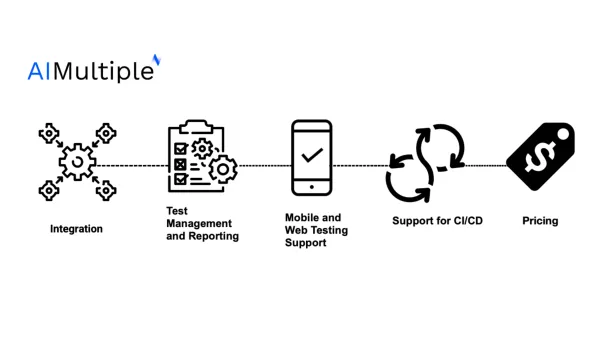We selected the top low-code test automation tools based on their ability to simplify the testing process, their integrations with low-code platforms, and their test documentation, management, and reporting capabilities. You can follow the links below to see our rationale.
| Low-code test automation tools | For | |
|---|---|---|
1. | Teams looking to automate tests with minimal scripting or technical overhead | |
2. | Testing across multiple devices and browsers in real-time, particularly for mobile applications | |
3. | Model-based test automation with a focus on risk-based testing and complex enterprise applications | |
4. | Low-code test creation in Agile environments | |
5. | API and service testing in regulatory and security compliance environments | |


Low-code test automation tools are gaining prevalence. In a survey of 3,300 IT professionals, 66% expressed a preference for codeless platforms to speed up digital transformation and respond better to business objectives.1
Comparison between the top low code test automation tools
| Product | Test Mgmt | Rating* | Mobile/Web Testing | Pricing |
|---|---|---|---|---|
| Katalon | ✅ | 4.3 based on 761 reviews | Both | Flat Rate, free trial available on request |
| Perfecto | ❌ | 4.5 based on 103 reviews | The low-code version offers web testing | Per Feature, a free version available with limited features |
| Tosca | ✅ | 4.2 based on - reviews | Both | Flat Rate, Demo available on request |
| Testifi CAST | ✅ | 4.9 based on 9 reviews | Both | Per Feature, Demo available on request |
| Parasoft | ✅ | 4.7 based on 9 reviews | Mobile testing | Per Feature, Demo available on request |
*Reviews are based on Capterra and G2. Vendors are ranked according to their number of reviews. All products above have continuous support for CI/CD.
While choosing the low-code test automation tools for analysis, we considered the following publicly verifiable parameters.
- Employee Size: Our analysis has shown that a company’s revenue correlates with its workforce size. With this in mind, we focus our efforts on companies with 30+ employees.
- References: We focus on vendors with proven success. The vendors we analyze should have positive feedback from at least one Fortune 500 company.
Top low code test automation tools analyzed
Katalon Studio
Katalon Studio is a low-code test automation tool that provides a range of features to help testers create and execute automated tests. Santander, ING, and SAP are among the clients of Katalon.2
Some of the key features of Katalon Studio include:
- Record and playback: Katalon Studio provides a record and playback feature that allows users to record their actions on a website or application and generate automated test scripts.
- Object repository: Katalon Studio provides an object repository that allows users to store and manage web and mobile application elements and easily reuse them in automated tests.
- Keyword-driven testing: Katalon Studio supports keyword-driven testing, which allows users to create automated test scripts using pre-defined keywords without writing any code.
Pros
- Users appreciate Katalon’s ability to record on mobile and desktop, as well as its customization options and self-healing test feature.
- Katalon is praised for its integration with various frameworks and tools, along with its low-code automation and supportive community.
- Users find the intuitive interface, in-built recorder, and the ability to automate API tests as beneficial features of Katalon.
Cons
- Users reported issues with Katalon’s integration with Azure and its high memory usage, as well as slow and non-responsive customer support.
- Some users found Katalon’s self-healing tests taking more time than usual, occasional crashes, and performance issues, including trouble with the object repository and recording feature.
- There were concerns about limitations in language support, lack of resources for learning, some previously free features becoming paid, and the tool not being very user-friendly or intuitive for coding.
Perfecto
Perfecto strives to improve CI/CD procedures and continuous testing to boost digital experiences. Testers may communicate from any location thanks to the cloud-based functionality. In the early stages of the SDLC, the advanced reporting tools guarantee issue capture and in-depth analysis for them.
Perfecto’s key features include the following:
- Real device testing: Perfecto allows users to test applications on real devices rather than simulators or emulators, which provides a more accurate representation of real-world usage.
- Cross-platform testing: Perfecto allows users to test web and mobile applications on various devices and operating systems, including Android, iOS, and Windows
- Continuous testing: Perfecto supports continuous testing by integrating with continuous integration and continuous delivery pipelines and providing feedback on code changes in real-time.
Pros
- Perfecto provides a range of testing capabilities for mobile apps, including automation, real user condition simulation, and access to the latest devices.
- Users appreciate Perfecto’s integration with CI-CD tools, the ability for multiple users to access shared devices, and comprehensive reporting features.
- Perfecto’s support team is highly regarded for their knowledge, quick response, and proactive updates about new features and usage statistics.
Cons
- Users report dissatisfaction with Perfecto’s new UI, specifically the automatic deletion of Device Groups without devices attached, which removes user details and can disrupt project workflows.
- Users have experienced issues with device load times and occasional unexpected device shutdowns, which can interfere with presentations and testing processes, and there’s a lack of clear instructions for script creation in the tool.
- A number of users mentioned wanting enhanced features such as email alerts from CI Dashboards, the ability to create folders in Asset pages, the ability to save and rename videos, and more detailed information about device usage.
Tricentis Tosca
Tricentis Tosca is a software testing tool that provides a range of features for test automation, test management, and continuous testing. Some of the key features of Tricentis Tosca include
- Model-based test automation: Tosca uses a model-based approach to test automation that allows users to create and maintain automated tests more efficiently.
- Test case design: Tosca provides a graphical interface for creating test cases that can be easily automated, even by users with little to no programming experience.
- Risk-based test optimization: By approaching testing from a risk-based perspective, Tosca lowers the risk in your software releases while reducing the total number of tests in your automation suite. This enables you to prioritize testing for functionality that is essential to your business.
- Test data management: Tosca provides tools for managing test cases, test suites, and test runs, as well as features for reporting and analytics.
Pros
- Tricentis Tosca offers a comprehensive automation suite with modules for various automation tasks.
- The software supports a codeless approach, making it accessible for non-programmers, and provides educational materials and training videos.
- Users appreciate the intuitive user interface, quick performance, cross-browser support, and the ability to integrate customer feature requests quickly.
Cons
- The software presents limitations such as a lack of full Mac OS compatibility, Git integration, and programming for looping and conditions.
- High cost, customization restrictions to only C# language, and issues with distributed execution are also reported.
Testifi CAST
CAST is a code analysis and testing tool that provides a range of features to improve code quality and reduce technical debt. Cast provides a modular framework that plugs into any toolchain. Testifi’s Task and Test Management integration transforms those tools into a complete DevOps platform.
With CAST, it is possible to create domain-specific languages (DSL) for any application, and automated testing can be performed by individuals who do not have programming expertise.
Some of the features of CAST include:
- Code quality analysis: CAST analyzes code for potential bugs, security vulnerabilities, and design flaws that may cause technical debt and negatively impact code quality.
- Static code analysis: CAST provides static code analysis, which scans the source code to identify potential issues based on predefined rules or guidelines.
- Broad functionality: CAST offers desktop, web, mobile, and API testing all in one package, reducing businesses’ reliance on additional tools with a shift left and test-first approach.
- Test coverage analysis: CAST analyzes test coverage to identify areas of code that may be missing test coverage.
Pros
- Testifi’s CAST framework provides a common language for diverse product creation parties, promoting deep collaboration.
- The software is highly customizable, supports end-to-end testing, and integrates well with various tools and platforms.
- Users find Testifi easy to automate and integrate into CI/CD pipelines, which improves the testing process and product quality.
Cons
- Adoption of Testifi’s CAST framework requires significant learning effort and time.
- Testifi’s reporting for local development is subpar and its user interface is still in beta stage.
- Despite its potential, Testifi is a young company with key features still under development.
Parasoft
Parasoft is a test automation platform that aims to aid organizations in improving the quality and reliability of their software products through features such as continuous testing, API security testing, and safety-critical testing.
IRS, Comcast, and Volkswagen Group are among the company’s list of clients.3
Additionally, Parasoft offers:
- Code analysis: Parasoft provides tools for analyzing code for potential issues, such as bugs, security vulnerabilities, and performance problems.
- Reporting and analytics: Parasoft provides features for reporting and analytics to help organizations track testing progress, identify issues, and improve their testing processes over time.
- Unit testing: Unit testing guarantees that each piece of software functions as intended. Automated unit tests help to ensure the quality of early-stage code.
Pros
- Parasoft C/C++Test includes features for building reliable software with integrated unit-testing, static analysis, and compliance checking.
- Users appreciate the tool’s capacity for static analysis using over 1600 predefined rules and its utility for unit testing, including the creation of testing frameworks and stubs.
- Other highlighted features include the ability to auto-generate unit test cases, run tests with large amounts of data, and the responsiveness of customer support.
Cons
- Users find the tools complex with a steep learning curve to adapt Parasoft C/C++ Test to their needs.
- The rule wizard for static analysis is perceived as difficult to understand, often requiring assistance from Parasoft.
- Concerns were raised about the cost of licenses, limited code review capabilities, and lack of customization and GitLab integration.
What are the key criteria for choosing a low-code test automation tool?

Here, we aim to choose low-code test automation platforms based on objective parameters. For example, the user experience of a test automation tool can be subjective; a person with some coding knowledge can prefer a more professional low-code platform and user interface, while a person with little to no knowledge would prefer a basic UI.
Not every tool will offer every feature covered below; this is one of the reasons why your specific needs and requirements are crucial when choosing a low-code test automation solution.
A low-code automated testing tool design involves a record and playback approach, making it a solution that doesn’t require extensive coding or programming skills. The following are our chosen benchmarks for low-code test automation tools:
- Test management and reporting: The tool should provide robust test management and reporting capabilities, allowing developers to track the results of their tests, identify any issues, and make data-driven decisions.
- Mobile and web testing support: The tool should support testing of both web and mobile applications, allowing developers to validate the functionality and performance of their applications.
- Support for CI/CD: The tool should integrate with CI/CD pipelines, allowing developers to automate the testing process and deploy their applications more quickly and efficiently.
- Cost: The pricing model of the tool can influence the business’s decisions.
- Integration with low-code platforms: The tool should integrate seamlessly with other platforms, allowing developers to test their applications without switching between multiple tools. This benchmark, however, should be evaluated based on your company’s web stack, and therefore, AIMultiple does not provide an evaluation.
FAQ
Who can benefit from using low-code test automation tools?
The advantages of low-code test automation solutions are not limited to Qualtiy Assurance (QA) specialists; even the product owner or non-tech people can utilize these to rapidly confirm functionality.
What are low-code test automation tools?
Low-code test automation tools allow users to create automated tests with minimal hand-coding. These tools use visual interfaces, drag-and-drop features, and pre-built components, making test automation accessible even to non-technical users or those with limited programming skills.
How do low-code tools differ from traditional test automation tools?
Traditional test automation tools require significant coding knowledge to create and maintain tests. Low-code tools, on the other hand, use visual workflows and pre-configured modules to reduce the amount of coding needed, enabling faster test creation and easier maintenance for a broader range of users.
Are low-code test automation tools suitable for complex testing scenarios?
Yes, many low-code tools can handle complex test cases by offering advanced customization options and the ability to write custom scripts when needed. However, for extremely complex or highly customized scenarios, you may still need some coding to fine-tune your tests.
Are there any disadvantages to low-code test automation?
While low-code tools can be powerful, they might:
Offer limited flexibility for highly complex, unique testing scenarios.
Require maintenance of the underlying low-code platform.
Create vendor lock-in, as you might rely on specific low-code platforms for your tests.
How do low-code test automation tools integrate with CI/CD pipelines?
Most low-code test automation tools offer integrations with popular Continuous Integration/Continuous Deployment (CI/CD) tools like Jenkins, GitLab, or Azure DevOps. This allows for seamless automation of tests in the development pipeline, ensuring that tests are executed automatically with every code change.
Are low-code test automation tools secure?
Reputable low-code test automation tools prioritize security, offering features like role-based access controls, secure environments, and encryption. It’s important to choose a tool with robust security practices, especially if you’re working on sensitive or regulated projects.
What are the benefits of low-code test automation solutions?
External Links
- 1. “The State of Application Development.” Outsystems. 2020.
- 2. Katalon AI-augmented Test Automation Platform.
- 3. Notable Clients - Parasoft.




Comments
Your email address will not be published. All fields are required.